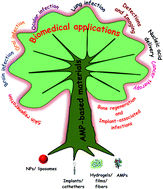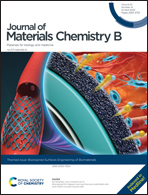Antimicrobial peptide-based materials: opportunities and challenges
Abstract
The multifunctional properties of antimicrobial peptides (AMPs) make them attractive candidates for the treatment of various diseases. AMPs are considered as alternatives to antibiotics due to the increasing number of multidrug-resistant (MDR) bacteria. However, bare AMPs have limited therapeutic potentials due to a low residence time in the blood circulatory system and susceptibility to proteases and an alkaline wound environment. These limitations are the major hurdles for AMPs to succeed as commercial drugs. In contrast, AMP-based materials, for instance, NPs, hydrogels, electrospun fibres, dressings and implants, could overcome these challenges and provide therapeutic efficacies to the conjugated AMPs superior to those of bare AMPs in different disease models. In this review, we discuss the preparation of different compositions of AMP-based materials and their therapeutic potential for the treatment of microbial infections in the brain, eyes, mouth, skin, lungs, and gastrointestinal and urinary tracts. Apart from antimicrobial potential, the applications of AMP-based materials in the regeneration of skin/bone, prevention of implant-associated infections, detection/imaging of bacteria, cancer therapy and gene delivery are discussed in this review. Lastly, we discuss different challenges that hinder the commercialization of AMP-based materials. Overall, this review provides a comprehensive account of the current progress and prospects of AMP-based materials for clinical applications.

- This article is part of the themed collections: 2022 Journal of Materials Chemistry B Most Popular Articles and Bioinspired Surfaces Engineering for Biomaterials


 Please wait while we load your content...
Please wait while we load your content...